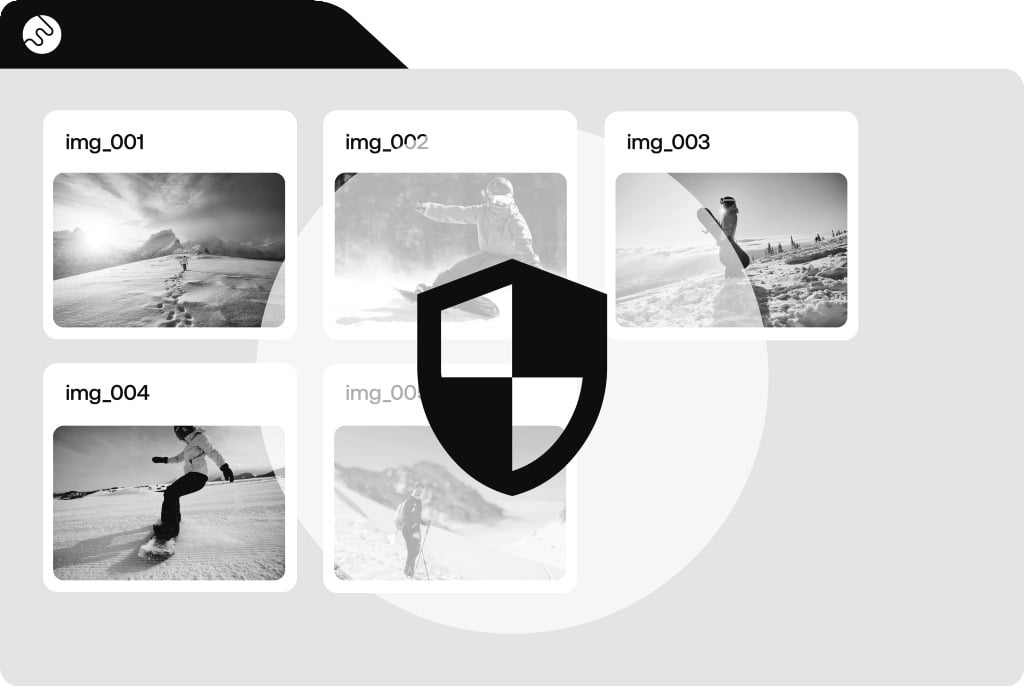
Digital Rights Management (DRM): Protecting your digital assets
Unauthorized use of digital assets can create serious headaches for organizations managing digital assets, however Digital Rights Management (DRM) can help you secure your content.
Unauthorized access, copyright infringement, and inconsistent brand use are common challenges for organizations managing valuable digital content. Without the right tools, protecting sensitive files and ensuring compliance with privacy and copyright regulations can feel overwhelming.
This is where Digital Rights Management (DRM) comes in. DRM helps safeguard your content by controlling access, protecting copyrights, and ensuring your assets are used as intended.
In this article, we’ll explore what DRM is, how it relates to Digital Asset Management (DAM), and how it helps secure your content while ensuring compliance.
What is Digital Rights Management?
Digital Rights Management, or DRM refers to technologies, policies, and processes that control access, usage, and distribution of digital content.
Notably, it prevents unauthorized access to assets - such as documents, videos, music, images, and proprietary software - by embedding usage restrictions directly into files or through digital asset management systems.
DRM meaning in a nutshell: DRM empowers organizations to control and monitor digital assets, ensuring only authorized users can access, share, or modify them.
This is crucial for businesses that own or handle licensed media or proprietary data, as well as content creators seeking to protect intellectual property.
How DRM works
- Usage restrictions: DRM defines how which users can access the content for viewing, editing, sharing, or printing based on licensing or organizational policies.
- Access control: DRM restricts access to authorized individuals or groups, safeguarding copyrighted works or licensed content.
- Expiration and revocation: DRM can set time-based limitations, automatically revoking access after a license expires.
Benefits of Digital Rights Management software
Digital media play a central role in brand strategy, customer engagement, and operational processes.
Without DRM, valuable copyrighted content is vulnerable to misuse, unauthorized duplication, or non-compliance with copyright laws, which can jeopardize brand consistency, intellectual property, and legal standing. Here are some of the benefits of DRM:
1. Protects intellectual property
DRM software prevents unauthorized duplication or distribution of your own copyrighted material, safeguarding organizations’ intellectual assets.
Without DRM, you risk losing revenue as a result of your content being shared or used freely, reducing its value.
2. Enforces licensing agreements
For material you have bought or licensed, DRM technology embeds usage restrictions and expiration dates within assets to ensures they are used within licensed terms, reducing legal and financial risks.
3. Enhanced content security and protection
DRM software applies encryption and access controls, making sensitive files accessible only to authorized users. This added security is essential for companies with high-value content.
4. Maintains brand consistency
DRM systems empowers marketing and brand managers to control how digital assets are used, ensuring every image, logo, and video aligns with brand standards.
5. Data privacy and regulatory compliance
For organizations subject to data protection regulations like GDPR, DRM provides access controls and documentation to ensure personal data is handled appropriately.
As digital content continues to expand, DRM enables organizations to maintain control over their assets, minimize misuse, and maximize value—making it an indispensable component of secure and compliant content management.
Common use cases for DRM in various industries
- Marketing, advertising, and communications: Ensures that licensed media files are used only within approved campaigns, aligned with brand guidelines and GDPR compliance.
- Museums, galleries, archives, and libraries: Controls access to digital reproductions, manages licensing agreements, and protects cultural assets while ensuring copyright compliance.
- Media and publishing: Helps control the distribution of e-books, videos, and music, preventing unauthorized sharing or copying.
- Manufacturing, retail, and e-commerce: Protects product images, brand assets, and marketing materials across channels, ensuring compliance with campaigns and stock availability.
- Sports and entertainment: Protects high-value media like live sports broadcasts and licensed content from unauthorized distribution.
However, not every organization requires the complete set of DRM features to meet their needs and can do well with using a digital asset management system to manage all of their images.
Learn more: How Digital Asset Management solves challenges for energy companies
Manage digital rights with a Digital Asset Management system
For companies managing large media collections, a Digital Asset Management system with built-in DRM features provides a secure, streamlined alternative to a DRM system.
Companies that don't need embedded usage restrictions can rely on a DAM's access control, license compliance, and rights management to protect their content—all in one platform, without extra DRM tools.
Learn more: 6 benefits of Digital Asset Management software
DRM functionality in DAMs
1. Access control
DAM systems centralize permissions, ensuring only authorized users can access the content for viewing, downloading, or sharing.
2. Automated license management
DAM systems track terms, set expiration dates, and send alerts as deadlines approach. Metadata like copyright strings and alt text are preserved, ensuring compliance with licensing agreements.
3. Content lifecycle management
DAM systems track asset versions, archive outdated files, and ensure assets are updated for compliance with usage guidelines.
4. Enhanced content security
DAM systems allow watermarking to deter unauthorized use of high-value assets, marking them with ownership information for added security.
Conclusion: Why choose a DAM for your DRM needs
In an era where digital content drives success, protecting and managing assets is vital.
By choosing a DAM for protecting your digital assets, companies gain tools to control content use, enforce licensing, and ensure compliance. A DAM system safeguards assets, helping teams maximize content value while maintaining security and regulatory adherence.
Ready to safeguard your digital assets?
Explore how a DAM system can transform your content strategy, ensuring your assets are secure and compliant from creation to distribution.
/digital-asset-management-software-business-case.jpg)
What is Digital Asset Management?
Discover what DAM is, understand the benefits, and explore its use cases in your industry.
/digital-asset-management-workflow.jpg)

